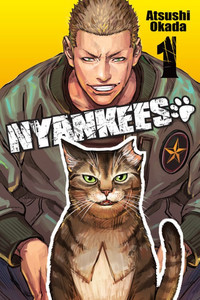Review
by Rebecca Silverman,Nyankees
GN 1
| Synopsis: |  |
||
Ryuusei's a drifter, living life as it comes and taking things as he finds them. He's just wandered into a new city and is trying to get a feel for the situation, which is complicated when he runs afoul of Taiga and his band. When Ryuusei unexpectedly defeats Taiga, he's offered leadership, but before he can decide, things heat up with a neighboring gang. And did I mention that all of these characters are cats? |
|||
| Review: | |||
If the cult '80s song “Stray Cat Strut” had a manga adaptation, it would look an awful lot like this. Nyankees is a gag manga about street toughs who are actually Stray Cats living in urban Japan, with the art shifting back and forth between depicting the characters as human and feline, with mixed results. Obviously a fondness for cats is going to make this even more entertaining than if you couldn't care less about kitties, but it does then carry the baggage of the fact that these are all homeless strays, which for readers in countries where that's considered a sad thing could take away some of the appeal of the story. (It's also clear that there's no TNR [trap/neuter/return] program going on here, which could be another issue for some readers.) That's not really what Nyankees is about, though – at its heart, it's meant to be a funny story about not only the way we tend to ascribe human motivations to our animals, but also just about how silly cats can be in general. The story follows Ryuusei, a big tabby cat with a star marking on his chest and one torn ear. He's new in town, a drifter looking for his former teacher, a rare male calico who taught him everything he knows. Ryuusei's not interested in local feline politics; he just wants to get some fish bits from the nice guy who feeds the strays and maybe hang out in a comfy cardboard box. Unfortunately for him, members of the local clowder see him as a threat, and they're not interested in just letting Ryuusei pass through without a fight. The fact that they have a very attractive female in their midst is the only thing that really catches Ryuusei's eye, but before he knows it, he's managed to defeat Taiga, the alpha, and is well and truly embroiled in neighborhood dynamics. Things work best when the characters either look like cats and act like humans or the reverse, with the second (look like humans and act like cats) being more amusing in general. The scene of Ryuusei settling himself into a slightly-too-small cardboard box for the ultimate comfort and relaxation and then being unable to get himself back out of it works especially well because it flips back and forth between showing a portly tabby and a big badass guy hunkered down in a carboard box, blurring the line between species particularly well. The added bonus that anyone with a cat will be familiar with their love of slightly-too-small boxes (and may have seen a cat get stuck in one) will immediately recognize what's going on as very real very much shows off the strengths of Okada's central concept. Yen Press' translation, on the other hand, at times seems to struggle for appropriate vocabulary. Mii, the one female cat in the story thus far, is usually referred to as a “molly,” a term some readers may not be familiar with. While technically speaking it is the term for an intact female cat who has not given birth (mother cats are “queens”), it mostly comes off as the translator trying really, really hard not to have to call Mii a “pussycat” or other similar, more familiar, term. Since the males are not referred to as “toms,” the equivalent term, but rather are just called cats, it feels a little awkward as well; it almost would have been better to just go with an older affectionate word, such as “moggie,” although ideally not gendering “cat” would probably work just fine. Likewise, each cat gang is referred to as a “clowder,” which again is the proper word for a group of cats but may be a little unfamiliar for readers not up on their semi-random cat vocab. It also, while being kind of a treat for cat people, is just a touch too serious for a story that clearly is more interested in being funny than in giving lessons in proper cat terminology. At the end of the day, Nyankees is an awful lot of fun. Okada's clear comfort level with drawing both cats and people makes the transitions between how each character is depicted work well, and the basic cat personalities come across clearly. The volume does feel more like it's setting things up than anything, although it's equally possible that there won't be any sort of major plot throughout the series. If that latter proves to be true, I'm not sure how long the story can stretch its concept, because cat fights and the amazing feline capacity to fool gullible humans into feeding them can only stretch so far in terms of storytelling. But however it turns out, this first volume is an entertaining concept brought nicely to life, and a series that cat lovers from whom Chii's Sweet Home and its ilk is too saccharine will want to check out. |
| Grade: | |||
|
Overall : B
Story : B-
Art : B+
+ Great juxtaposition between cat and human, strongly understands its subject matter |
|||
| discuss this in the forum (4 posts) | | |||
| Production Info: | ||
|
Full encyclopedia details about Release information about |
||